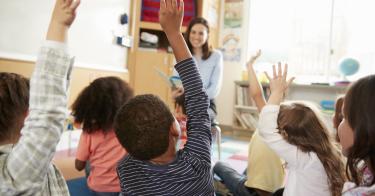It’s back-to-school season, yet millions of children won’t return to in-person instruction for the foreseeable future. But this fall, some families are improvising to provide some kind of in-person instruction for their children. Earlier this year, when school districts proved unwilling or unable to meet families’ desires for safe, in-person instruction during the COVID-19 pandemic, parents across the nation banded together in “pandemic pods” to take their children’s education into their own hands. In many places, the pods are continuing this school year. And some school districts are not amused.
"In recent weeks, discussions have surfaced on creating well-meaning ‘pandemic pods’ and ‘micro-schools’ that un-enroll children and hire private teachers,” read an August 13 statement from the Denver Board of Education. “We want to strongly encourage our families to keep the connection they have to their school and educators.”
The statement also asked families to “consider the equity implications of creating or joining pandemic pods,” noting that “for pods to reflect the demographics of the district, there must be three students-of-color for every one white student, two students who qualify for free-and-reduced price lunch for everyone who does not ...”
“Families have an absolute right to work together and pool resources to provide instruction or tutoring,” reads a Fairfax County, Va., public-school press release to families forming pandemic pods. It should have stopped there.
The district—which will be online-only this fall—is quite displeased that parents are finding alternative learning arrangements for their children. Although the district conceded it “can’t control these private tutoring groups,” it wanted parents to know that it does “have concerns that they may widen the gap in educational access and equity.”
This argument is curious. Public-school proponents generally argue that education is a “public good”—an individual’s level of education affects others in the community beyond themselves. Americans have broadly agreed to socialize the cost of education because a functioning republic requires an educated citizenry capable of self-government and of the republic’s maintenance. Another societal benefit is that better-educated individuals are more likely to be productive workers who pay taxes and less likely to be dependent on welfare. The proliferation of education also fosters advancements in science and technology that benefit everyone, and leads to a more enlightened society overall.
Yet in arguing that pods will exacerbate inequity, public-school proponents are not only treating education primarily as a private benefit, but they’re also treating education as a zero-sum game: If some children know more, that will hurt other children.
Buried in this argument is an implicit admission by the districts that the crisis online learning the districts are providing is inferior to the education students could be receiving in pods. Inequity is only an issue if the pods are superior to what the district schools provide while simultaneously being inaccessible to some students based on their socio-economic status. Yet rather than expand access to the pods, districts are trying to shame better-off parents into refraining from providing their children with a superior education.
If education truly benefits the public at large, then it makes no sense to hold some kids back from achieving their true potential. Disadvantaged kids need to be lifted up. They aren’t helped by keeping other kids down. The best way to improve the lot of disadvantaged kids is to empower their parents to choose the learning environment that works best for them. Having educated citizens is in the public interest; it shouldn’t matter where that education occurs.
Indeed, those concerned about educational inequity should turn a critical eye to the existing district system. In Virginia, children from low-income families are more than two and a half grade levels behind their non-poor peers in eighth-grade reading, and black students are nearly three grade levels behind their white peers. What about education “equity” for these children?
Fairfax County currently spends more per pupil than the national average of $15,000 annually. Denver is slightly under national figures at $12,200, and, astonishingly, Washington, D.C., spends $31,000 per child per year. If those education dollars followed the child, low-income families would have much greater access to a wide variety of learning options.
Yet defenders of the status quo have worked incessantly to prevent families from accessing alternatives to the residentially assigned district system—the doors to which are largely closed at the moment to in-person instruction. That’s because, due both to school-district myth-making and status-quo bias, we’ve come to believe that this is how education must delivered. Any failure of the one-size-fits-some system to achieve its stated goals is blamed not on a flaw in the system but rather on a lack of sufficient funding, as though D.C. schools would perform at the level of Massachusetts if only they spent $35,000 or $40,000 per pupil instead of $31,000.
Pods reject the assumption that residentially assigned and government-run schools are the best way to educate kids. Indeed, the near-infinite variety in the approach to podding calls into question the very notion of a “one best way.”
Kids can’t wait for district schools to reopen. States should immediately provide emergency education savings accounts (ESAs) to families, allowing them to take a portion of the money that would have been spent on their child in school to the learning environments of their choice. Five states—Arizona, Florida, Mississippi, North Carolina, and Tennessee—already empower families with ESAs to use for private-school tuition, tutors, textbooks, online learning, special-education services and therapies, and a host of other options. In Arizona, applications for ESAs this summer are triple what they were last year. They’re the perfect policy pairing with pandemic pods.
Adults should be doing everything in their power right now to provide education continuity to children. That goes for school-district officials, too. Embracing families’ decision to use pods or any other option that fits their children’s needs would demonstrate that districts really are interested in the “public good” of public education—regardless of where it takes place.
This piece originally appeared in the National Review




